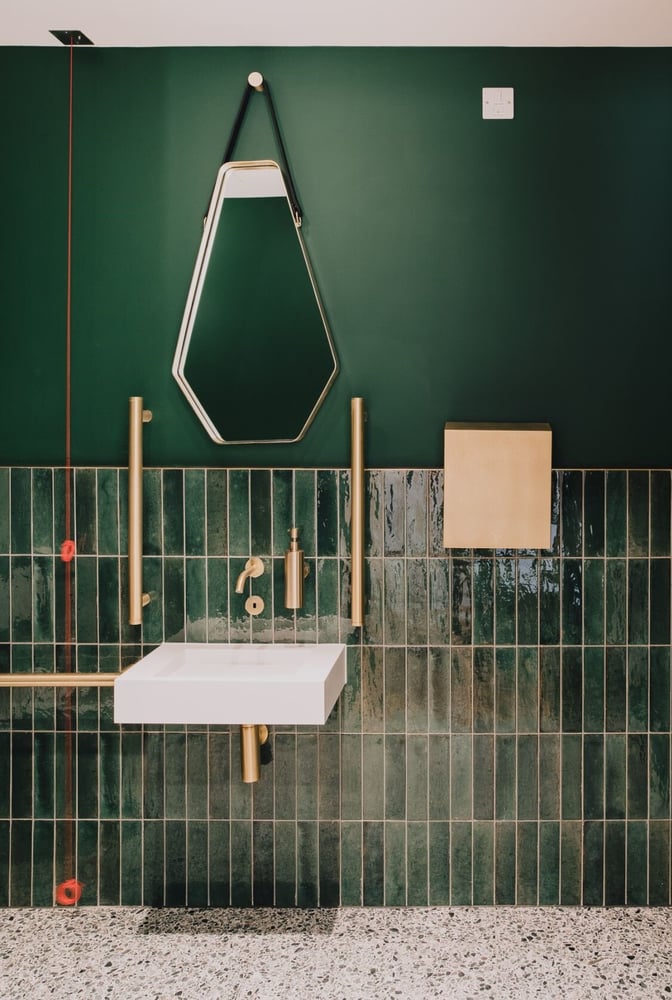Principles of Universal Design
Adopting universal design principles is a key trend in constructing accessible restrooms and bathrooms. This method ensures that spaces are usable by people of all ages, abilities, and mobility levels. A seamless inclusive bathroom design is facilitated by elements like broad doorways, level thresholds, and open floor layouts. Universal design makes spaces usable for all, blending functionality with inclusivity.
Stylish Grab Bars and Supportive Accessories
The concept of traditional grab rails is evolving. Designers now incorporate stylish grab bars that double as towel racks or soap holders, elegantly fusing form and function. These additions offer support without sacrificing the bathroom's overall aesthetics.
Modern grab bars combine support with style, enhancing both safety and aesthetics.
 Smart and Hands-Free Fixtures
Smart and Hands-Free Fixtures
Beyond accessibility, smart and hands-free fixture integration is a trend that reflects the digital age. In addition to improving hygienic practices and convenience, voice-activated controls, motion-sensor lights, and touchless faucets all contribute to the modern bathroom's beauty.
Level-Access Showers
Level-access showers, also known as zero-threshold showers, are becoming increasingly popular for their sleek, modern look. Eliminating the barrier between the shower and the rest of the bathroom not only improves accessibility but also creates a visually cohesive and spacious atmosphere. Shower seats can be designed to blend seamlessly with stylish designs, maintaining both comfort and practicality.
Contrasting Colours and Textures
To make spaces navigable for individuals with visual impairments contrasting colours or textures is crucial. Designers use contrasting colours, textures, and PVD finishes not just for safety but as essential parts of the overall design scheme. This approach adds depth and interest to the space.
Adjustable and Customisable Features
Accessibility isn't one-size-fits-all, and designers are recognising the importance of customisable features. Removable grab rails and shower seats, adjustable-height countertops, sinks, and mirrors accommodate various users, ensuring everyone can comfortably use the bathroom.
Inclusive Lighting Design
Thoughtful lighting design is vital for accessibility. By incorporating both natural and artificial lighting, designers create well-lit spaces that minimise shadows and reduce accident risks. This trend enhances safety and contributes to a welcoming atmosphere.
Space-Saving Solutions
Even compact bathrooms can be accessible. Designers are exploring innovative space-saving solutions like fold-down shower seats, wall-mounted vanities, and easily reachable storage options. These innovations maximise functionality without sacrificing style.
Non-Slip Flooring
Non-slip flooring remains a timeless trend and a priority in accessible bathroom design. Textured tiles, slip-resistant mats, and water-resistant flooring options enhance safety while adding a tactile element to the overall design.
Artistic Inclusivity
Beyond functionality, the newest trend in accessible and inclusive bathroom and washroom design embraces artistic inclusion. Through the use of striking colour palettes, opulent finishes, and distinctive wall textures, designers show that creativity and accessibility can coexist, enabling people to express their individuality in a setting that is generically designed.
Artistic inclusivity allows personal expression within universally designed spaces.
At Fitzroy of London, we recognise that luxury accessible bathrooms and washrooms are no longer confined to mere functionality; they are becoming showcases of thoughtful design that prioritises inclusivity. The newest developments in accessible toilets and washrooms demonstrate that everyone deserves a space that is not only practical but also aesthetically beautiful, as designers continue to push the frontiers of creativity. This evolution marks a significant step toward a more inclusive and design-conscious future for all.

%20in%20Accessible%20Washroom%20Design%20-%20IPL_FoL_190521_7310-1.jpg?width=1280&height=853&name=Understanding%20Light%20Reflectance%20Value%20(LRV)%20in%20Accessible%20Washroom%20Design%20-%20IPL_FoL_190521_7310-1.jpg)
